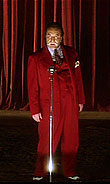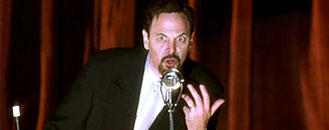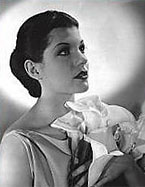|
Threads: |
Related: "Llorando" Song Lyrics |
Magician & EmCee at Club Silencio
|
|
LINE | TRANSLATION |
|
Spanish: |
No hay banda. No hay orquesta. |
There's no band. There's no orchestra. |
|
French: |
Il n'est pas de orchestra. |
There's no orchestra. |
|
French: |
Un trombone à coulisse. |
A slide-trombone. (pan: coulisse <–> backstage?) |
|
French: |
Oune trabonne en sourdina. |
A muted trumpet. |
|
French: |
J'aime le son d'une trombone en sourdine. |
I love the sound of a muted trumpet. |
|
Spanish: |
Señoras y señores, el Club Silencio les presenta - La Llorona de Los Angeles, Rebekah Del Rio. |
Ladies and gentleman, the Club Silencio presents - The weeping Lady of Los Angeles, Rebekah Del Rio. |
Spanish lines at the Pool Party
|
|
SPANISH | TRANSLATION |
|
Camilla: |
Yo nunca fuí a Casablanca con Luigi. |
I never went to "Casablanca" with Luigi. |
|
Someone: |
Qué lástima. |
What a pity. |
|
Adam: |
¿Qué va? |
Duh! or Who cares! or What are you up to? |
Spanish lines at Havenhurst
|
|
SPANISH | TRANSLATION |
|
Rita: |
¡Silencio! |
Quiet! or Silence! |
|
Rita: |
No hay banda. No hay orquesta. |
There's no band. There's no orchestra. |
|
Rita: |
¿Donde estás? |
Where are you? |
Cookie at Park Hotel
|
|
SPANISH (pachuco) | TRANSLATION |
|
Cookie: |
¡Mira, ese! |
Look, man! |
|
Cookie: |
¡Oye carnal! |
Listen, brother! |
Note: When Mr. Roque makes a phone call ("the girl is still missing"), the man he speaks to answers his phone with "Allô?", which is also French.
The reason for the Magician speaking English, Spanish, and French is, he is speaking to three people: Betty, Rita, and Aunt Ruth. Aunt Ruth is associated with French because inside her apartment is clearly seen the book Tout Paris, which is a guide to the art of French decoration. Rita's involvement is a back-link to Camilla who is heard to speak Spanish at the pool party. - (Mark Beers)
Trivia: Geno Silva (Cookie/EmCee) on his introduction to Rebekah Del Rio
So my agent sends me over what, I guess, was supposed to be sides. All it said was, "Mexican emcee introduces Rebekah Del Rio." No dialogue.
Nothing. I was really mad, and I threw it across the room! I said, "I'm not going to do this. this is s---!"
You get really angry at stuff like that. You think you're being exploited, and you think that
somehow you're Tom Cruise or something!
I wrote three different introductions, and I typed them out neatly. One was in pachuco dialect; one was in a Vegas, "Hey! Ho!" style; and one was a very straightforward introduction in Spanish.
 So I go to the set at the old, crumbling Tower Theater, and I meet David. I said, "David, if you have a chance, look at these introductions to Rebekah. See what you think." He said, "Oh! That's great!" A
little while later, when we were going to do the scene, he calls me over and says, "Look, let's combine these. Lets do a little bit of each. We'll make this work. this is going to be great! We're
going to have some fun."
So I go to the set at the old, crumbling Tower Theater, and I meet David. I said, "David, if you have a chance, look at these introductions to Rebekah. See what you think." He said, "Oh! That's great!" A
little while later, when we were going to do the scene, he calls me over and says, "Look, let's combine these. Lets do a little bit of each. We'll make this work. this is going to be great! We're
going to have some fun."
You know that intro I do for Rebekah? I made that up: "La Llorona de Los Angeles." La Llorona in Southwestern legend, is a mythic, spooky character of your childhood. It is a wailing woman you hear at night. She's crying because she lost her two children in the Rio Grande. It is a story you hear all over the Southwest. When she was singing "Crying" I said, "David, how about we call her La Llorona - the crying woman - of Los Angeles, because that's what she's doing." Some people will get it and some people won't.
Trivia: Richard Green (The Magician) on the workout of his French/Spanish monologue
 Then David called and said: "It's a real dark
magician and it's real key to the movie. The part is in English, but I kind of have a vision of it being in French and Spanish as well."
Then David called and said: "It's a real dark
magician and it's real key to the movie. The part is in English, but I kind of have a vision of it being in French and Spanish as well."
After the script arrived the next morning, I tried to call David but couldn't reach him. So I thought "I'll have to translate it."
So I got on the phone with a friend of mine who was fluent in French and literally
read him the part. He translated it and spelled it out, and then I recorded him saying it so I would have a reference. I
did the same thing with a Spanish translator. Then I retyped the whole script, so
there were David's original lines and then the French and then the Spanish. Now I'm sitting here trying to learn a script that's in three languages!
I'm going to arrive on the set Monday morning and I've never worked with David, but if he's like anyone I've ever worked with, there is not going to be any time for us to sit down and figure out which lines are Spanish and which lines are French. I better come up with some kind of concept. I'm a writer, and I basically went through it and chose when to say
French and when to say Spanish, how to structure it, came up with as couple of ideas, did costuming that Saturday afternoon, arrived on Monday morning, handed David the full translation and said "I've kind of got this approach." It was the greatest experience I've ever had on a set in my life. He dug what I was doing. I dug the direction he wanted me go in.
 Rita Hayworth
connection?
Rita Hayworth
connection?
I have figured out why Rita spoke Spanish in her sleep. It's a reference to Gilda (starring Rita Hayworth), a movie from which Rita copped her temporary identity. It is because before Rita Hayworth was Rita Hayworth, she was a heavyset Spanish girl named Margarita Carmen Cansino. Harry Cohn of Columbia would submit her low hairline to electrolysis and the pudginess to a diet. Rita in the film is remembering her past before she was Hayworth. When the low-browed heavy set woman [Rebekah Del Rio] begins to sing Crying in Spanish, Rita begins to cry and then Betty does too. The reason Rita cries is because that woman is the young girl Rita used to be, the pudgy Spanish Dancing Girl whose father raped her each night. - (margotchanning)
Related: Real-life connection to Rita Hayworth | Rebekah Del Rio's make-up